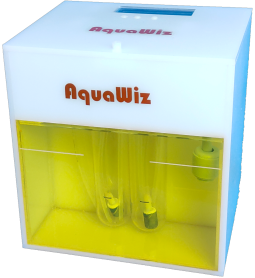I saw someone mention a different type of automatic alkalinity tester that does not do a titration and so requires no re-agent, so I just had to look it up and read about it. Its a product called the AquaWiz and it uses aeration and pH differentials to calculate the alkalinity of the sample water as compared to a known reference sample.
From reading the manual, it appears to work like this. A reservoir holds the reference water within the device. There are 2 test chambers, a left and a right. The right side contains an air stone and a couple of tubes for moving water into and out of. The left side contains an air stone, tubes and a pH probe. Tank water gets added to right chamber, and the left side gets it's reference sample refreshed from the reservoir. Then the 2 sides are equally aerated for 15 minutes. Once the test chambers are fully aerated, the pH of the left side with the reference sample is measured, and then the left side gets drained back to the reservoir. Now the right side, with the aerated tank water, gets pumped to the left chamber, and the pH is measured. Then they calculate the dKH based on the difference in pH from the aerated reference sample and the tank water.
The odd bits are that they don't calibrate the pH probe as the specific pH does not matter, only the differential between the 2 aerated samples.
They claim a 0.05 accuracy, but they also mention that re-calibration is required based on how far apart the dKH of the reference sample is compared to the tank dKH, with a 1.0 dKH difference requiring a weekly re-calibration, and a 0.5 dKH difference able to go up to a month between re-calibrations. Re-calibrating involves measuring the dKH of the reference sample in the reservoir and entering into their online app.
It certainly is a unique and different way of trying to determine the tank alkalinity. Thoughts on the method?
(You can read the installation manual below to better understand the concept)
 www.aquawiz.net
www.aquawiz.net
From reading the manual, it appears to work like this. A reservoir holds the reference water within the device. There are 2 test chambers, a left and a right. The right side contains an air stone and a couple of tubes for moving water into and out of. The left side contains an air stone, tubes and a pH probe. Tank water gets added to right chamber, and the left side gets it's reference sample refreshed from the reservoir. Then the 2 sides are equally aerated for 15 minutes. Once the test chambers are fully aerated, the pH of the left side with the reference sample is measured, and then the left side gets drained back to the reservoir. Now the right side, with the aerated tank water, gets pumped to the left chamber, and the pH is measured. Then they calculate the dKH based on the difference in pH from the aerated reference sample and the tank water.
The odd bits are that they don't calibrate the pH probe as the specific pH does not matter, only the differential between the 2 aerated samples.
They claim a 0.05 accuracy, but they also mention that re-calibration is required based on how far apart the dKH of the reference sample is compared to the tank dKH, with a 1.0 dKH difference requiring a weekly re-calibration, and a 0.5 dKH difference able to go up to a month between re-calibrations. Re-calibrating involves measuring the dKH of the reference sample in the reservoir and entering into their online app.
It certainly is a unique and different way of trying to determine the tank alkalinity. Thoughts on the method?
(You can read the installation manual below to better understand the concept)
AquaWiz
 www.aquawiz.net
www.aquawiz.net


















